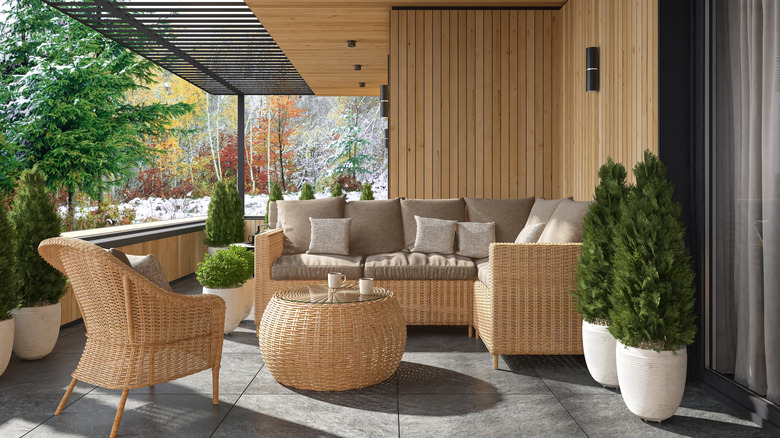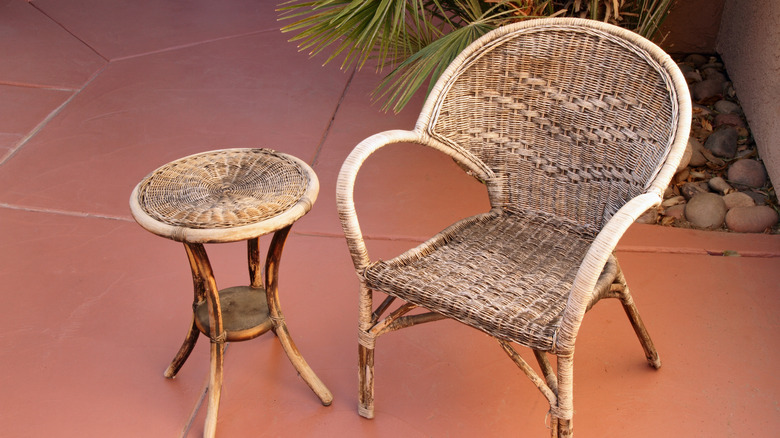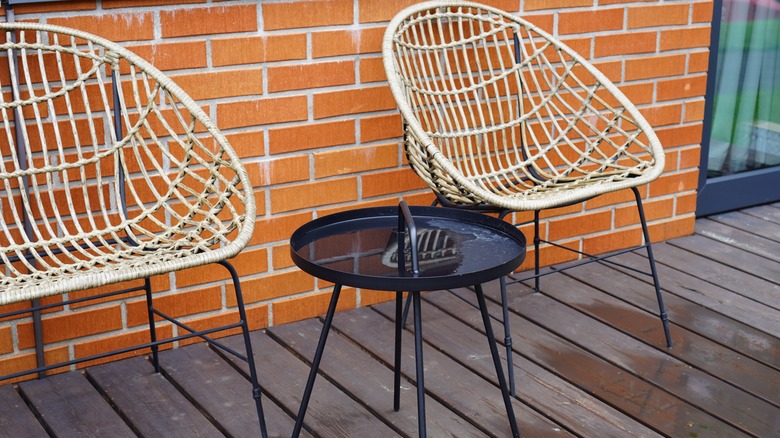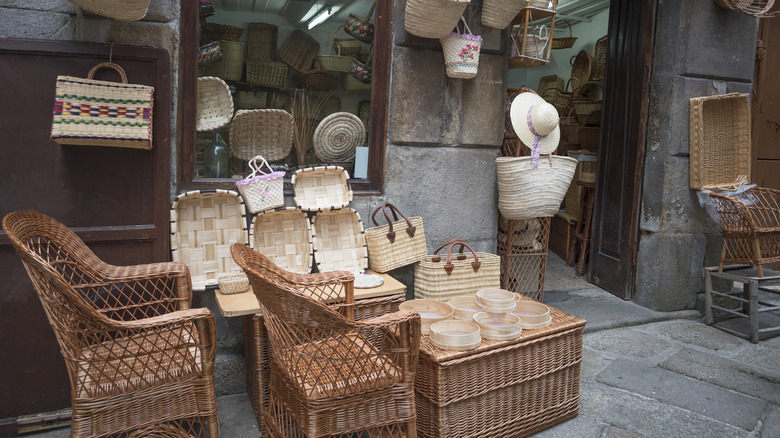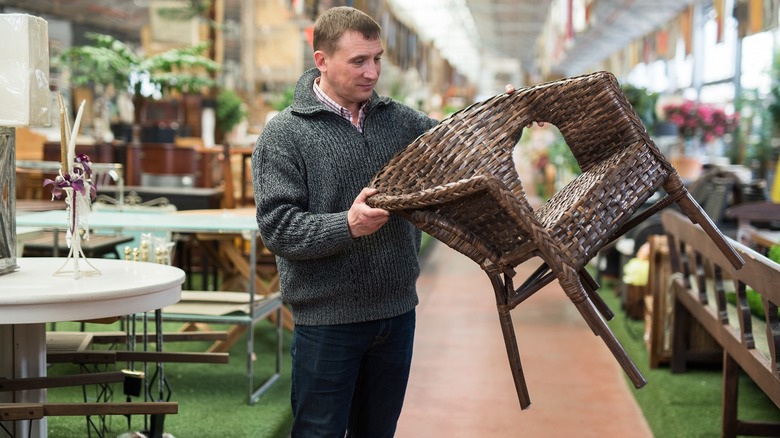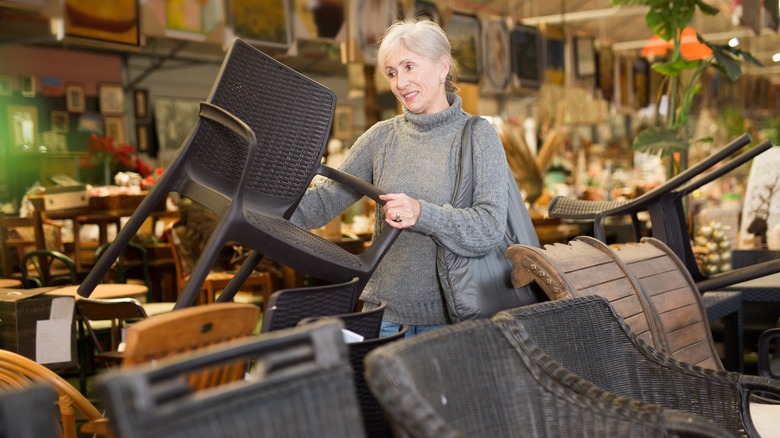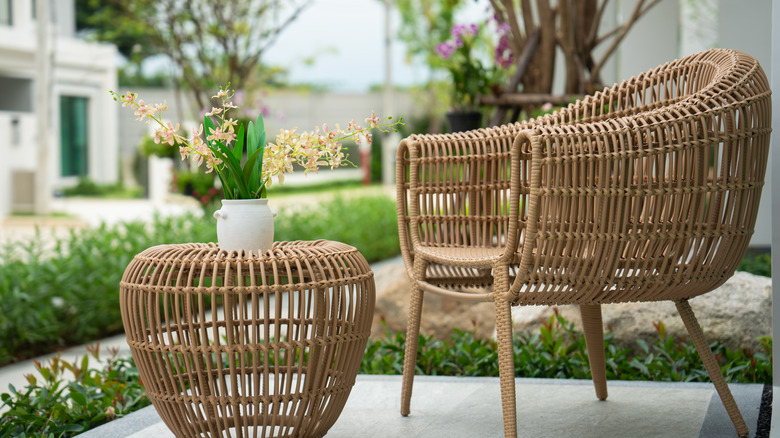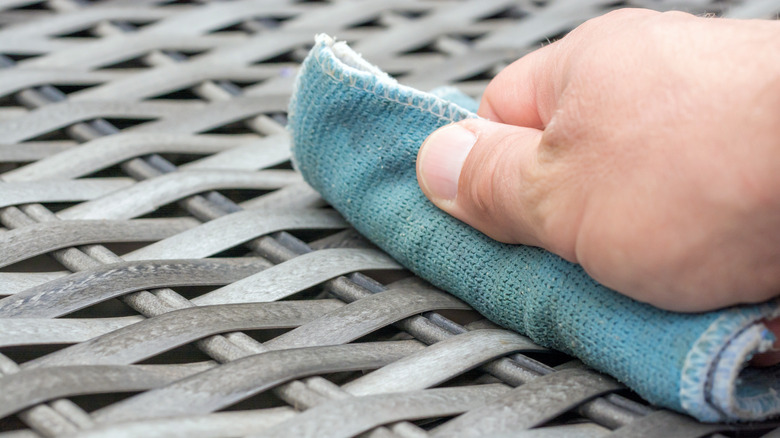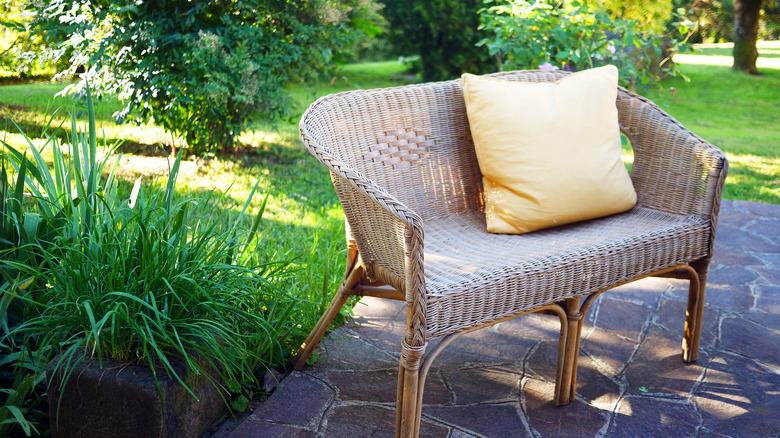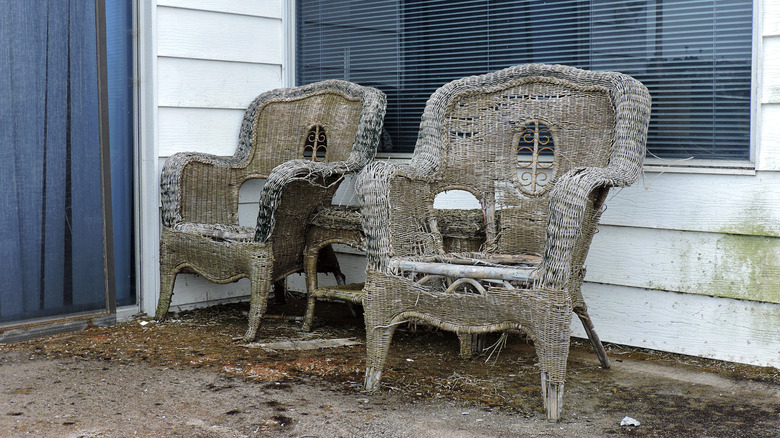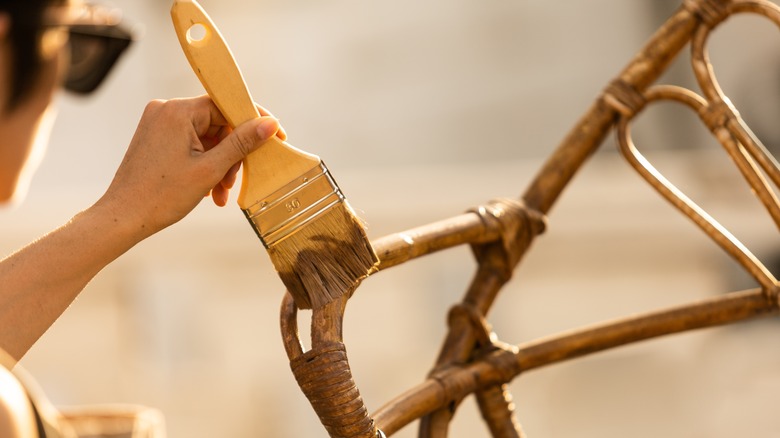The Downsides To Wicker Furniture You Haven't Considered
We may receive a commission on purchases made from links.
As you're considering different trendy ideas for designing the perfect patio, you'll need to choose the right type of furniture for the space. Wicker furniture can certainly add a beautiful touch to any area, inside or outside. Its timeless look brings a feeling of warmth and welcome — just what you might want for your patio. However, before you start shopping for a few new wicker items, there are some downsides you might not have thought about. Understanding not only the benefits, but also the drawbacks, of this furniture type is crucial to ensure you don't make a decision that you'll end up regretting.
Before we get into the downsides of wicker furniture, it is important to take a minute to address a common point of confusion. While many people use the terms wicker and rattan interchangeably, there are some key differences between wicker and rattan. Wicker is a term that refers to a particular style of weaving. Therefore, the furniture pieces may be either natural or synthetic, depending on the type of material that is used. Rattan, on the other hand, is a specific type of material. It is very fibrous and similar to bamboo. Rattan is often woven to make wicker furniture, but all wicker furniture is not rattan. Now that's out of the way, let's unpack some of the potential drawbacks to wicker furniture pieces that you'll want to be cognizant of before plumping for that alluring new set.
Many natural wicker pieces won't last very long
If you've been wondering whether wicker furniture is durable enough to last, you may be a bit disappointed with the answer, particularly for natural pieces. Natural wicker doesn't always have the longest lifespan. For example, despite its beautiful appearance, wicker furniture made from bamboo may only last for up to 10 years. And, that's assuming it's taken care of properly. The problem is that bamboo's hollow center can break or split over time, leaving the furniture damaged.
Natural wicker furniture made from rattan should offer a longer lifespan than other natural materials. This is because of how fibrous rattan is. It offers stronger and more flexible construction, which can allow it to last for up to 20 years — potentially twice as long as bamboo wicker pieces. Two decades is a very decent lifespan, however, any type of natural wicker furniture can be more vulnerable to rough handling than metal and wood pieces. So, you'll need to be particularly careful when moving pieces around on your patio or bringing them inside for storage. If you're really looking for long-lasting wicker furniture, particularly for the outdoors, then you might want to consider a high-quality synthetic material, such as resin or or high-density polyethylene (HDPE) which are generally more durable and have longer lifespans.
Natural wicker furniture shouldn't be left outdoors
When you're looking for the best type of wicker for your patio furniture, you may be surprised to learn that natural options probably aren't ideal. As noted above, natural wicker is made from plant materials, such as bamboo or rattan. These materials will absorb moisture, which can not only create an environment for mold to grow, but can also threaten the structural integrity of the pieces. Moreover, the hot UV rays from the sun can also impact the durability of these natural materials, leading to cracks and other damage over time. Some may assume that covering the furniture will be sufficient to protect it. However, while better than leaving it fully exposed to the elements, a certain amount of moisture will still be able to get in.
If you want to use natural wicker furniture on your outdoor deck or patio, you should plan on storing it indoors. It will be important to bring the pieces in after each use to protect them against damage. If this sounds too tedious, then purchasing natural wicker for your deck or patio might not be the best choice. You might decide that a synthetic option is a better fit. These materials are designed for outdoor use and will be able to withstand the heat and moisture that will spell serious trouble for rattan, bamboo, and other natural materials.
Premium wicker furniture can be expensive
If you've been thinking about purchasing wicker furniture because of its beauty, you may have been overlooking one other potential downside: the cost. Natural wicker furniture — particularly high-quality pieces — can be expensive. Depending on the item, you could pay upwards of $2,000 or even $3,000.
So, why is wicker furniture so expensive? Well, quality pieces are made by hand. The special weaving process is involved, making it a labor-intensive endeavor. This means that no two pieces will be exactly alike, but that, of course, comes at a premium. Plus, natural materials, particularly rattan, are more expensive to begin with. Another factor that can contribute to the higher costs is shipping rates. Wicker pieces tend to be bulkier than those made from other materials, such as metal or plastic. This means that they'll need to be packaged in larger boxes, which cost more money to ship than more compact furniture items.
Assessing the quality of a piece of wicker furniture isn't always easy — especially if shopping online
While some wicker furniture items are artfully-made, high-quality pieces, others don't live up to the same standard of construction. If you're not an expert, it may be challenging to distinguish between the two. If the item isn't well-made, the weave may become loose and unravel. Cheap pieces are also more prone to damage or scratching. The last thing you want to do is spend a lot of money on a piece of furniture that you think should offer you a decade or more of use, only to have it break or look shabby after a short period of time. Shopping for wicker furniture online can be even more problematic, as it will be more challenging to evaluate an item's quality through a screen.
While judging quality isn't easy, there are some key indicators that you can look for when trying to evaluate a piece, whether in person or online. Inspect the item as closely as possible, paying particular attention to the weave. The weave pattern should look even and the strands should sit tightly together. If you notice wide gaps or an uneven finish, then it is probably not a high-quality item that you're looking at. Also note the frame material. Aluminum is a top choice because of its durability and rust resistance. Aluminum is also lightweight, which can be particularly beneficial if you're planning on moving the furniture around or bringing it into and out of the house regularly. If you're shopping in person, you may also want to look at where the legs attach to the body of the chair or couch. Check for tight connections and ensure that the piece doesn't wobble or feel unstable when you sit or place weight on it.
Less expensive wicker doesn't look or feel as nice as quality pieces
If you're shopping on a tight budget, you might decide that compromising on quality won't be the end of the world, since you'll still enjoy beautiful pieces of furniture that you can use when entertaining. However, you might want to rethink this reasoning, as there is another downside to consider. Mass-produced, fast-furniture wicker items simply don't match the beauty and charm of higher-quality options. As mentioned earlier, the weave pattern won't be as tight and could start to unravel, potentially marring the attractiveness of the piece within a season. A chair with strands of material pulling out and unraveling certainly isn't going to do anything to enhance the aesthetics of an indoor or outdoor space. Similarly, because they are made so much more quickly to keep costs down, less expensive pieces can also lack the symmetry and precise craftmanship that makes their more expensive counterparts look so beautiful. Plus, if the frame isn't a high-quality material or the joints aren't securely attached, sitting on the chair or sofa isn't going to feel comfortable (or safe, even).
There are even differences between the looks of cheaper and more expensive synthetic wicker pieces. High-density polyethylene is used for most higher-quality options. This synthetic resin is much more resistant to scratching, cracking, and fading than polyurethane or polyvinyl that is often used for less-expensive pieces, and which tend to stick to one's skin, become brittle in the sun, and start looking shabby relatively quickly. Scratched and faded furniture is only going to serve as an eyesore. Less expensive pieces may also have a shinier finish (as opposed to the matte finish on quality ones) that can just make them look cheap and unexciting.
You may have a more difficult time storing wicker furniture due to its bulkier size
Understanding how to store patio furniture properly is important. However, when you're talking about wicker furniture, proper storage is even more essential. If you recall, natural pieces are not designed to be left outside. This means that you will need to bring them in after every use and keep them in a climate-controlled garage, laundry room, or basement. Even more resilient synthetic wicker may still become damaged with harsh conditions, excessive moisture and snow. It is best to store it indoors over the winter months. However, due to its bulkier size, you may run into some problems storing your furniture. Unlike some more streamlined patio chairs that may stack, not all wicker furniture is stackable.
Before finalizing your decision to purchase a furniture set, you should assess the available storage locations to make sure you have sufficient space. If you want natural wicker furniture, ensure that you not only have enough room to store it, but that the storage area is close enough to your outdoor patio or deck that you won't have to constantly haul the pieces long distances or up and down stairs. You can also consider using the furniture inside the house. Natural wicker, in particular, but even some high-quality synthetic pieces are attractive and can double as indoor seating. Finally, if you're looking for synthetic options, you could also consider a more compact set, such as these Flash Furniture Lila Modern Rattan Indoor/Outdoor dining chairs that are stackable.
With the weave pattern, wicker can be difficult to clean
As you think about maintaining your wicker furniture — which will be necessary to keep it looking its best — you shouldn't brush over the potential challenges you'll face with cleaning it. Dirt and debris can become trapped in the weave. And, because these pieces are so tightly woven, removing this debris will not be the simplest task. Moreover, wicker (particularly natural varieties) is also susceptible to staining from spills.
Regular cleaning will be essential to prevent staining and keep dirt and debris from building up or getting caked into the tighter crevices of the weave pattern. The easiest way to clean wicker furniture is with the brush cleaning tool from a vacuum cleaner. This will enable you to suck out much of the trapped debris. For hard-to-budge dust that your vacuum cleaner doesn't seem to shift, a can of compressed air (like Office Depot's Cleaning Duster) may help do the trick. When a deeper cleaning is necessary — at least once per year — make a cleaning solution by adding a few drops of mild dish soap into a bowl or bucket with some water. Use a microfiber cloth — like one of the Homexcel Microfiber Cleaning Cloths — to wipe down each piece. Then, follow up with a dry cloth to remove as much excess liquid as possible. You'll also want to use this same soapy solution to treat any spills on the furniture. Sop up excess liquid immediately before wiping the surface with the soap and water to prevent staining. If dish soap isn't delivering results, you can also try a purpose-built cleaner that's labeled for use on wicker or rattan, such as the CLR Brands Outdoor Furniture Cleaner.
You'll likely find chairs and benches to be uncomfortable without added cushions
Wicker furniture, whether natural or synthetic, is not known for its soft and cushy feel. In fact, quite the opposite is true. Chairs and sofas will have a hard seat and hard back that you are unlikely to find comfortable without the aid of a few cushions. So, as you're considering whether wicker is the best choice for your indoor or outdoor space, don't forget to account for the fact that you may need to purchase some cushions. Beyond the added cost, cushions can also impact the way the furniture looks, so you'll need to be careful to choose options that match your design vision.
Most wicker lounge sets have included cushions. But, if the pieces you're considering don't come with cushions (which is common with outdoor dining sets), you'll have to source some that are the right size, won't slide around on the seats, and if you're going to use the pieces outside, have weather-resistant fabric. You should also consider the foam filler. For example, memory foam cushions, like these Sunrox Gel Memory Foam Chair Cushions, may offer better support than those filled with polyester batting.
Natural wicker furniture can deteriorate faster in humid climates
If you live in a humid climate, you should also be prepared for the possibility that your wicker furniture may not last as long as it would in a dryer environment. When humidity levels are high, the likelihood of mold or mildew growing on natural wicker will be increased. If you live in such an area, bringing the pieces inside for storage will be even more critical. Even leaving them in a screened-in porch can still be problematic because of the amount of moisture that may be in the air.
To minimize the risk of mold damage, there are a few things you can do. First, you might decide that opting for synthetic furniture is the best choice. As we shared earlier, these materials are more resistant against water damage and mold, so you can leave your furniture outside (or even on your covered porch) with less worry. If you still want to opt for natural wicker, plan on bringing it in after each use and make sure that the room where you want to store it doesn't have high humidity levels. If your garage doesn't have its own air conditioner, for example, it may still be too humid.
Keeping up with regular cleaning will be even more important to prevent dirt or pollen from sticking to the furniture and creating favorable conditions for mold to grow. Covering the furniture on your screen-in porch when it is not in use and placing pieces over an outdoor rug — like the Genimo Outdoor Rug — instead of directly on a deck or patio surface can also help minimize the chance of mold or mildew growing.
Refinishing wicker furniture can be tricky
As your wicker furniture starts to show its age, its finish may not look as nice as it once did. You might decide that you want to refinish the piece to give it some new life. However, refinishing wicker furniture can be tricky, so you'll want to keep this in mind before you finalize your decision to purchase some for your patio or living room.
The first problem with refinishing lies in stripping the old paint or lacquer. When you consider all of the tiny crevices between the weave on these pieces, you'll start to understand just how difficult it will be to remove all of it. Moreover, depending on the quality of the material, it may become damaged or start to unravel as you try to strip or sand off the old finish.
If you manage to strip the finish — or just decide to skip this step in favor of painting over it — you're also likely to run into some problems. Just as those crevices make it difficult to remove old paint or finishes, they will also make it near impossible to ensure even coverage without making the paint run. If you want to attempt to paint wicker furniture to bring it back to life, you'll definitely need a good spray gun, such as the Graco Magnum Project Painter Plus Paint Sprayer, to give you the best shot at evenly covering the surface and getting into those crevices.
